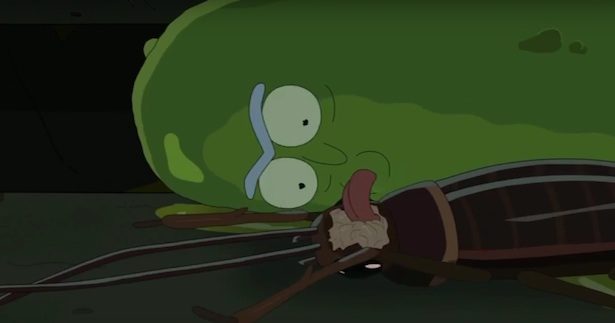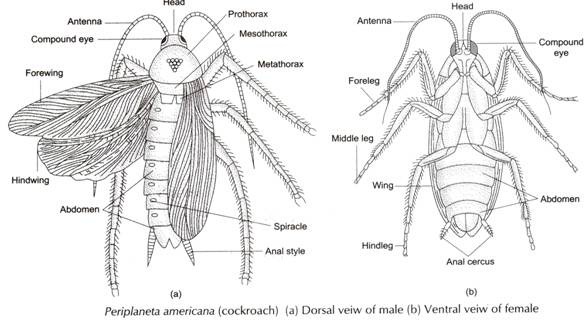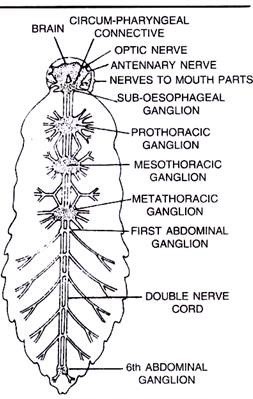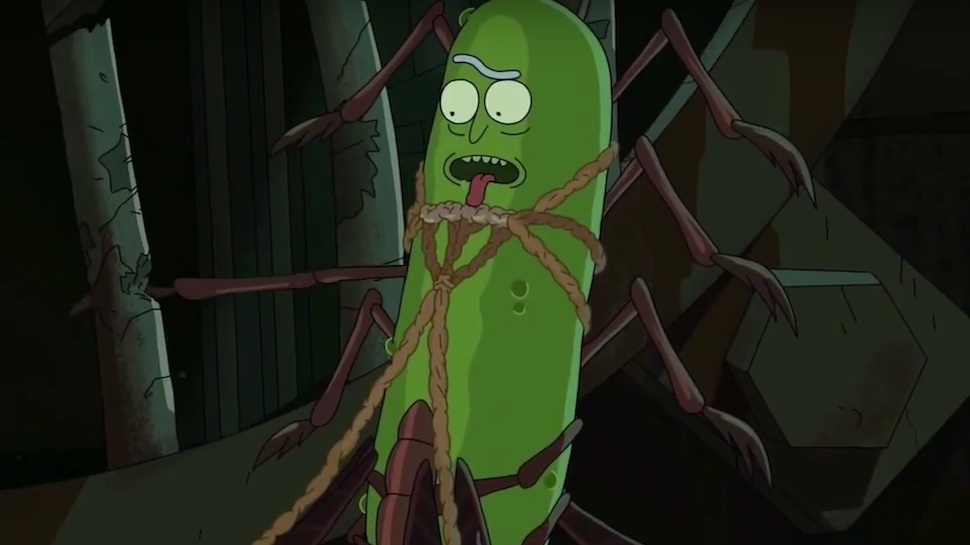To things that are true: Rick & Morty is awesome and last week’s Pickle Rick episode was awesome2.
Like always, the episode carried a heavy load of science with it, but there’s one thing I really want to look at here – controlling a cockroach. Can you hijack and control a cockroach’s nervous system with your (albeit, brine soaked) tongue?
Short answer: no.
Longer answer: yes, but not with your tongue. With other things.
Let’s get into the science of cyborg cockroaches.
Setting things up – Rick, changes himself into a pickle, gets washed into the sewers and lures a cockroach closer by biting his lip and “bleeding” out some pickle brine. Once the roach is close enough to his mouth, Pickle Rick chomps the roach at the junction of its head and thorax, killing it (or stunning it…it’s hard to tell for sure, and we’ll come back to that later). Rick removes the part of the roach’s exoskeleton that covers its brain and pokes around with his tongue until the roach’s legs start moving. From there, he manipulates the roach’s legs to move his pickle body on top of the roach and then controls the roach as it moves him along the ground. Later, he’s shown to have made a system of roach legs that he controls via a series of tissue which he manipulates with his tongue.
What happens next is…you should watch the episode to find out.
No words…no words.
So – ignoring the Rick turning himself into a pickle part – is hijacking a cockroach’s nervous system possible?
Yep. And it’s relatively easy. So easy, in fact, there’s a company that will sell you a kit that teaches you how to do it for yourself.
But let’s get this thing rolling in order.
First Things First – Cockroach Anatomy 101.
A cockroach is an insect, so its body is made up of three distinct regions: the head, the thorax (three sections) and the abdomen. Most roaches have only vestigial wings and can’t fly – or can only fly for short period. Roaches have antennae on their heads and two “antennae-like” sensory receptors called cerci at the end of the abdomen. Between the cockroach’s eyes with a thousand lenses, its cerci and antennae, roaches can sense (and respond) to stimulation extremely quickly. Turn on the lights, brush up against one, try to sneak up on one, etc. It’s like they know you’re coming…
Going inside to the nervous system of a cockroach, it’s…simple. It’s not centralized like ours. The main parts are the brain (also called the supra-esophageal ganglia) and ganglia. If you look at the cockroach from the side, the brain would be above the esophagus. Also in the head, but below the esophagus, is the sub-esophageal ganglia which connects to the double spinal cord that runs through the ventral side of the body and connects to 6 more ganglia.
Obviously, ganglia is the key word here.
Simply, ganglia are a cluster of nerve cells in one place. Looking at them in a nervous system, ganglia appear as a swelling along the nerve fiber. They’re not quite other “brains” since they’re lacking more complex organization, but they are centers of nerve control and signaling.
It’s this distribution of the cockroach’s nervous system that allows for a headless roach to live for a week after decapitation, only then dying of thirst.
Back up to the brain and sub-esophageal ganglia, the roach brain is largely concerned with incoming sensory stimuli, while the sub-esophageal ganglia is focused on motion – controlling the legs, the wings and the mouth.
What does all of this have to do with Pickle Rick commandeering a cockroach’s nervous system?
I’m getting there.
Second Things Second: How do Nerves Fire? Neurons and Action Potentials
The simplest answer – electricity.
The inside of a nerve cell, or neuron, is more negative than the outside thanks to the neuron actively pumping positively charged sodium ions out, while keeping a few positively charged potassium ions and negatively charged protein molecules in. The “more negative” has a value of about -70 mV (millivolts). The value of -70 mV is said to be the cell’s resting potential, and we can say that the cell is polarized it’s a region with its own distinct charge.
When the nerve cell receives a stimulus – in our roach’s case, say, from an antenna, sodium channels in the cell membrane open, allowing some sodium ions from the outside in. Bringing positive ions into the neuron decreases the neuron’s negative charge and starts it moving the charge towards the positive. If the charge falls to -55 mV, then voltage-gated sodium channels in the membrane open and sodium ions flood into the cell, depolarizing it. This depolarization “fires” the cell sending a signal which is called an action potential, down its branches (the axons) in a wave. The depolarization causes the axons to release a chemical signal of their own (a neurotransmitter) to the next nerve cell, which acts as the stimuli for that nerve cell.
Meanwhile, following depolarization back in the body of the neuron, membrane-based potassium channels open and pump positive potassium ions out, once again decreasing the charge inside the cell, making the inside more negative again. The charge in the cell can fall to around -77 mV (hyperpolarization) before the neuron’s sodium/potassium pumps work to return the cell to the resting potential of -70mV. And things are ready to go again when the next stimulus hits.
Hit a neuron review via Crash Course Anatomy & Physiology:
Third Things: DIY Cyborg Cockroaches
If all of this has your mad scientist jones going, you’re in luck. Cockroaches have been a model for researchers studying autonomous robot systems for many years. The goal is that someday (sooner rather than later), researchers and engineers will be able to create autonomous robots that mimic insects in their motion and control systems.
At the basic level is the home-brew RoboRoach kit from Backyard Brains. With the RoboRoach kit, you can create your own cyborg cockroach that will respond to commands sent from an app on your phone.
The RoboRoach method has the roach surgeon snip off the roach’s antenna and insert electrodes into the stumps. The electrodes connect to a miniature circuit board which then wirelessly connects to your phone.
Swipe either to the right or left, and the circuit board stimulates the antennae via the electrode. The roach will turn the opposite direction of the stimulation. In the roach’s mind, the stimulation makes it think it has brushed up against something, and it wants to avoid that…thing, whatever it is.
If this is all tickling a familiar part of your brain, you may have seen it on the “Super Power Tech” episode of White Rabbit Project on Netflix. In the episode, former Mythbuster, Kari Byron visited the labs of backyard brains and performed the surgery on a cockroach herself.
For more advanced cyborg roach creation, recent research at Texas A&M developed a system that directly stimulated frontmost (prothoracic) ganglion rather than having the signals processed through the brain. This allowed, according to their published findings, control of the cockroaches’ locomotion with high repeatability.
One thing the researchers at Texas A&M did note was the methods they chose (stimulate the ganglia directly, rather than through the antennae) was to avoid the phenomenon of habituation, that is, after receiving artificial stimuli (electricity) for a period of time, the roach’s nervous system learns to ignore it and the response rate drops off a cliff. We’ll come back to this shortly.
Another research team, this one at Case Western Reserve University, found the neurons that control both speed and movement. After inserting 27 wires into the central complex region of a roach’s brain, they could both track and map the patterns of neural activity that resulted in the roach’s motion. When the researchers stimulated the same neurons in the same fashion, they could produce the same movements in the roaches. Brain hijack!
What’s the point of all this research with roaches and other insects’ brains? Again – control of cyborg insects and creation of insect-like robots that perfectly mimic insect behavior. Why? Researchers at UC Berkeley who created the CRAM robot based on a cockroach design and behaviors, claim that small, autonomous, and virtually indestructible robots would be ideal for search and rescue missions through rubble and confined spaces, among other things.
Cockroaches may creep you out now, but someday, a robot one just might save your life.
Or, of course, carry a small nuclear weapon into an otherwise secure room and explode.
You were thinking it.
Okay, Okay – So What Does All of This Have to Do With Pickle Rick?
We started all of this by asking if Pickle Rick could control a cockroach’s motion with a briny tongue. Okay, probably not. From the animation, he’s poking hard in the brain, which contains a lot of sensory neurons, but he probably would’ve gotten better bang for his buck had he dodged the brain and dug underneath it to the sub-esophageal ganglion. That’s the direct line to your cockroach’s motor systems, and Rick needed to be a touch more delicate in his poking.
But putting that aside, why did anything on the roach move at all when he was just poking around with his tongue? We can probably chalk that one up to mechanically gated channels in the membranes of the neurons – these open in response to the membrane being stretched, which poking the brain would most likely do. Also – Pickle Rick’s briny saliva would have a high concentration of sodium ions in it, helping make those neurons reach threshold and depolarize quickly once those mechanically gated channels open up.
Also – the crunch when he had the roach by the head in his mouth? He’d have to be careful – bite too hard and you could disconnect the nerves that run from the sub-esophageal ganglia down the thoracic ganglia which control the legs directly. No amount of brain-poking will help if the wires are cut.
And speaking of those thoracic ganglia? Remember when Rick was using roach pieces to “saw” through the bars that were holding back the rats? He was touching clumps of tissue with his tongue to make the various legs move. Yeah – we’re going with those being the thoracic ganglia, harvested from the roaches he’d killed. They’re directly responsible for leg movement.
The one slight issue with the whole scenario of multiple legs used by tonguing the ganglia? As mentioned earlier, those ganglia would habituate quickly, and just start ignoring the stimuli. But – Pickle Rick quickly yanked off and discarded a roach leg when it wasn’t sawing well, so the idea that he knew about habituation, and had a stock of roach legs and ganglia certainly isn’t that far-fetched.
Overall though – was it all possible, then? Does the roach science pan out?
You know…it does. Okay, okay, okay – not if a human pickle tongues roach brains and ganglia, but still. All the pieces of controlling the respective pieces of a roach’s nervous system exist and have been shown to work – even to the point of Backyard Brains selling kits to anyone who wants to make their own cyborg roach.
So kudos, Pickle Rick. Nicely scienced.
As for rat brains and pieces…yeah. You’re on your own.













